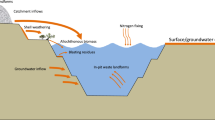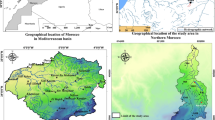Abstract
The coupling between chemical weathering (including silicate, carbonate and pyrite weathering) and physical erosion is of high interest in active mountain belts. Participation of pyrite weathering which, results in CO2 emission to the atmosphere, also is of great research attention. Nevertheless, the responses of the (de-)couplings to landslide and typhoon are unclear. We used records of riverine TDS (total dissolved solids) and TSS (total suspended solids) with high-frequency sampling during typhoons to estimate chemical denudation rates of silicate (CDRsil), carbonate (CDRcarb), pyrite (CDRpyrite) and physical denudation rates (PDR) in two adjacent catchments, eastern Taiwan. Results show that the CDRsil in the two catchments is approx. 10-fold higher than the global mean, whereas the CDRcarb, CDRpyrite and PDR are over 15-fold higher than the global averages. Landslides likely elevate carbonate and sulfate dissolution, and streamflow is a kinetic control on the CDRs. Among CDRs, CDRsil remains constant with various landslides and typhoons. Yet, CDRcarb and CDRpyrite rapidly respond to typhoons and then contribute more CO2 emission. In sum, landslides expose fresh minerals to enhance chemical weathering; typhoons, which transport the dissolved solids within a short time and prompt new rainwater for weathering, are also dominant agents. We demonstrate the importance of dynamic partitioning of sulfuric and carbonic acid on silicate weathering for quantitative estimation of weathering-associated CO2 budget in active mountain belts.



taken from Chen (1998). Carbonate weathering (calcite) dominates streamwater chemistry in the two rivers. Note that most carbonate weathering is prone to be driven by H2SO4 rather than H2CO3






Similar content being viewed by others
References
Berner RA, Lasaga AC, Garrels RM (1983) The carbonate–silicate geochemical cycle and its effect on atmospheric carbon-dioxide over the past 100 million years. Am J Sci 283:641–683. https://doi.org/10.2475/ajs.283.7.641
Blattmann TM, Wang SL, Lupker M, Marki L, Haghipour N, Wacker L, Chung LH, Bernasconi SM, Plotze M, Eglinton TI (2019) Sulphuric acid-mediated weathering on Taiwan buffers geological atmospheric carbon sinks. Sci Rep 9:8. https://doi.org/10.1038/s41598-019-39272-5
Calmels D, Gaillardet J, Brenot A, France-Lanord C (2007) Sustained sulfide oxidation by physical erosion processes in the Mackenzie River basin: climatic perspectives. Geology 35:1003–1006. https://doi.org/10.1130/g24132a.1
Calmels D, Galy A, Hovius N, Bickle M, West AJ, Chen MC, Chapman H (2011) Contribution of deep groundwater to the weathering budget in a rapidly eroding mountain belt, Taiwan. Earth Planet Sci Lett 303:48–58. https://doi.org/10.1016/j.epsl.2010.12.032
Chen CH (1998) Geological Series of Taiwan No. 11: metamorphic rock in Taiwan. Central Geological Survey, MOEA, Taiwan. ISBN 9789570227215
Das A, Chung CH, You CF (2012) Disproportionately high rates of sulfide oxidation from mountainous river basins of Taiwan orogeny: sulfur isotope evidence. Geophys Res Lett 39:6. https://doi.org/10.1029/2012gl051549
Dessert C, Dupre B, Francois LM, Schott J, Gaillardet J, Chakrapani G, Bajpai S (2001) Erosion of Deccan Traps determined by river geochemistry: impact on the global climate and the 87Sr/86Sr ratio of seawater. Earth Planet Sci Lett 188:459–474
Emberson R, Hovius N, Galy A, Marc O (2016a) Chemical weathering in active mountain belts controlled by stochastic bedrock landsliding. Nat Geosci 9:42–47. https://doi.org/10.1038/ngeo2600
Emberson R, Hovius N, Galy A, Marc O (2016b) Oxidation of sulfides and rapid weathering in recent landslides. Earth Surf Dyn 4:727–742. https://doi.org/10.5194/esurf-4-727-2016
Emberson R, Galy A, Hovius N (2018) Weathering of reactive mineral phases in landslides acts as a source of carbon dioxide in mountain belts. J Geophys Res Earth Surf 123:2695–2713. https://doi.org/10.1029/2018jf004672
FranceLanord C, Derry LA (1997) Organic carbon burial forcing of the carbon cycle from Himalayan erosion. Nature 390:65–67. https://doi.org/10.1038/36324
Gabet EJ, Mudd SM (2009) A theoretical model coupling chemical weathering rates with denudation rates. Geology 37:151–154. https://doi.org/10.1130/g25270a.1
Gaillardet J, Dupre B, Louvat P, Allegre CJ (1999) Global silicate weathering and CO2 consumption rates deduced from the chemistry of large rivers. Chem Geol 159:3–30. https://doi.org/10.1016/s0009-2541(99)00031-5
Gaillardet J, Calmels D, Romero-Mujalli G, Zakharova E (2019) Global climate control on carbonate weathering intensity. Chem Geol. https://doi.org/10.1016/j.chemgeo.2018.05.009
Galy A, France-Lanord C (1999) Weathering processes in the Ganges-Brahmaputra basin and the riverine alkalinity budget. Chem Geol 159:31–60. https://doi.org/10.1016/S0009-2541(99)00033-9
Gibbs RJ (1970) Mechanisms controlling world water chemistry. Science 170:1088–1090. https://doi.org/10.1126/science.170.3962.1088
Hartmann J, Moosdorf N, Lauerwald R, Hinderer M, West AJ (2014) Global chemical weathering and associated P-release—the role of lithology, temperature and soil properties. Chem Geol 363:145–163. https://doi.org/10.1016/j.chemgeo.2013.10.025
Hilley GE, Chamberlain CP, Moon S, Porder S, Willett SD (2010) Competition between erosion and reaction kinetics in controlling silicate-weathering rates. Earth Planet Sci Lett 293:191–199. https://doi.org/10.1016/j.epsl.2010.01.008
Larsen IJ, Almond PC, Eger A, Stone JO, Montgomery DR, Malcolm B (2014) Rapid soil production and weathering in the Southern Alps, New Zealand. Science 343:637–640. https://doi.org/10.1126/science.1244908
Li YH (1976) Denudation of Taiwan island since Pliocene Epoch. Geology 4:105–108. https://doi.org/10.1130/0091-7613(1976)4%3c105:DOTIST%3e2.0.CO;2
Maher K, Chamberlain CP (2014) Hydrologic regulation of chemical weathering and the geologic carbon cycle. Science 343:1502–1504. https://doi.org/10.1126/science.1250770
Meybeck M (1987) Global chemical weathering of surficial rocks estimated from river dissolved loads. Am J Sci 287:401–428. https://doi.org/10.2475/ajs.287.5.401
Meyer KJ, Carey AE, You CF (2017) Typhoon impacts on chemical weathering source provenance of a High Standing Island watershed, Taiwan. Geochim Cosmochim Acta 215:404–420. https://doi.org/10.1016/j.gca.2017.07.015
Milligan AJ, Morel FMM (2002) A proton buffering role for silica in diatoms. Science 297:1848–1850. https://doi.org/10.1126/science.1074958
Millot R, Gaillardet J, Dupre B, Allegre CJ (2002) The global control of silicate weathering rates and the coupling with physical erosion: new insights from rivers of the Canadian Shield. Earth Planet Sci Lett 196:83–98. https://doi.org/10.1016/s0012-821x(01)00599-4
Moore J, Jacobson AD, Holmden C, Craw D (2013) Tracking the relationship between mountain uplift, silicate weathering, and long-term CO2 consumption with Ca isotopes: Southern Alps, New Zealand. Chem Geol 341:110–127. https://doi.org/10.1016/j.chemgeo.2013.01.005
Raymo ME, Ruddiman WF (1992) Tectonic forcing of late Cenozoic climate. Nature 359:117–122. https://doi.org/10.1038/359117a0
Riebe CS, Kirchner JW, Granger DE, Finkel RC (2001) Strong tectonic and weak climatic control of long-term chemical weathering rates. Geology 29:511–514. https://doi.org/10.1130/0091-7613(2001)029%3c0511:stawcc%3e2.0.co;2
Riebe CS, Kirchner JW, Finkel RC (2004) Erosional and climatic effects on long-term chemical weathering rates in granitic landscapes spanning diverse climate regimes. Earth Planet Sci Lett 224:547–562. https://doi.org/10.1016/j.epsl.2004.05.019
Rugenstein JKC, Ibarra DE, von Blanckenburg F (2019) Neogene cooling driven by land surface reactivity rather than increased weathering fluxes. Nature 571:99–102. https://doi.org/10.1038/s41586-019-1332-y
Shih YT, Chen PH, Lee LC, Liao CS, Jien SH, Shiah FK, Lee TY, Hein T, Zehetner F, Chang CT, Huang JC (2018) Dynamic responses of DOC and DIC transport to different flow regimes in a subtropical small mountainous river. Hydrol Earth Syst Sci 22:6579–6590. https://doi.org/10.5194/hess-22-6579-2018
Spence J, Telmer K (2005) The role of sulfur in chemical weathering and atmospheric CO2 fluxes: evidence from major ions, δ13CDIC, and δ34SSO4 in rivers of the Canadian Cordillera. Geochim Cosmochim Acta 69:5441–5458. https://doi.org/10.1016/j.gca.2005.07.011
Stallard RF (1980) Major elements geochemistry of the Amazon River system. PhD Thesis, MiT/Woods Hole Oceangraphic Institute, WHOI-80-29
Torres MA, West AJ, Li GJ (2014) Sulphide oxidation and carbonate dissolution as a source of CO2 over geological timescales. Nature 507:346–349. https://doi.org/10.1038/nature13030
Torres MA, West AJ, Clark KE, Paris G, Bouchez J, Ponton C, Feakins SJ, Galy V, Adkins JF (2016) The acid and alkalinity budgets of weathering in the Andes-Amazon system: insights into the erosional control of global biogeochemical cycles. Earth Planet Sci Lett 450:381–391. https://doi.org/10.1016/j.epsl.2016.06.012
West AJ, Galy A, Bickle M (2005) Tectonic and climatic controls on silicate weathering. Earth Planet Sci Lett 235:211–228. https://doi.org/10.1016/j.epsl.2005.03.020
West AJ (2012) Thickness of the chemical weathering zone and implications for erosional and climatic drivers of weathering and for carbon-cycle feedbacks. Geology 40:811–814. https://doi.org/10.1130/g33041.1
Acknowledgements
This study was sponsored by Taiwan Ministry of Science and Technology (MOST 107-2621-B-002-003-MY3, MOST 106-2116-M-002-020), Austrian Science Fund (FWF I 1396-B16), NTU Research Center for Future Earth (107L901004), and Environmental Protection Bureau at Hualien County. The authors would like to thank the reviewers and Dr. Niels Hovius for their constructive comments and Li-Chin Lee, Tse-Yang Teng and Meng-Chang Lu for their assistance in sampling.
Author information
Authors and Affiliations
Corresponding author
Additional information
Responsible Editor: Sharon A. Billings.
Publisher's Note
Springer Nature remains neutral with regard to jurisdictional claims in published maps and institutional affiliations.
Supplementary Information
Below is the link to the electronic supplementary material.
Rights and permissions
About this article
Cite this article
Wang, CH., Liou, YS., Chen, PH. et al. Tropical cyclones likely enhance chemical weathering but suppress atmospheric CO2 consumption in landslide-dominated catchments. Biogeochemistry 154, 537–554 (2021). https://doi.org/10.1007/s10533-021-00805-8
Received:
Accepted:
Published:
Issue Date:
DOI: https://doi.org/10.1007/s10533-021-00805-8




